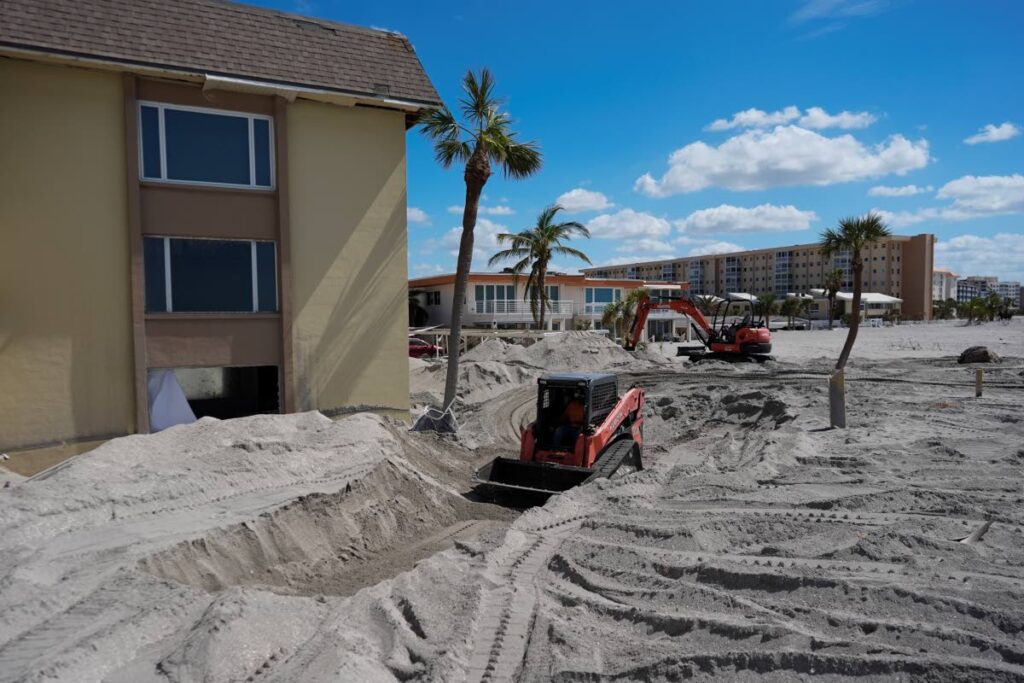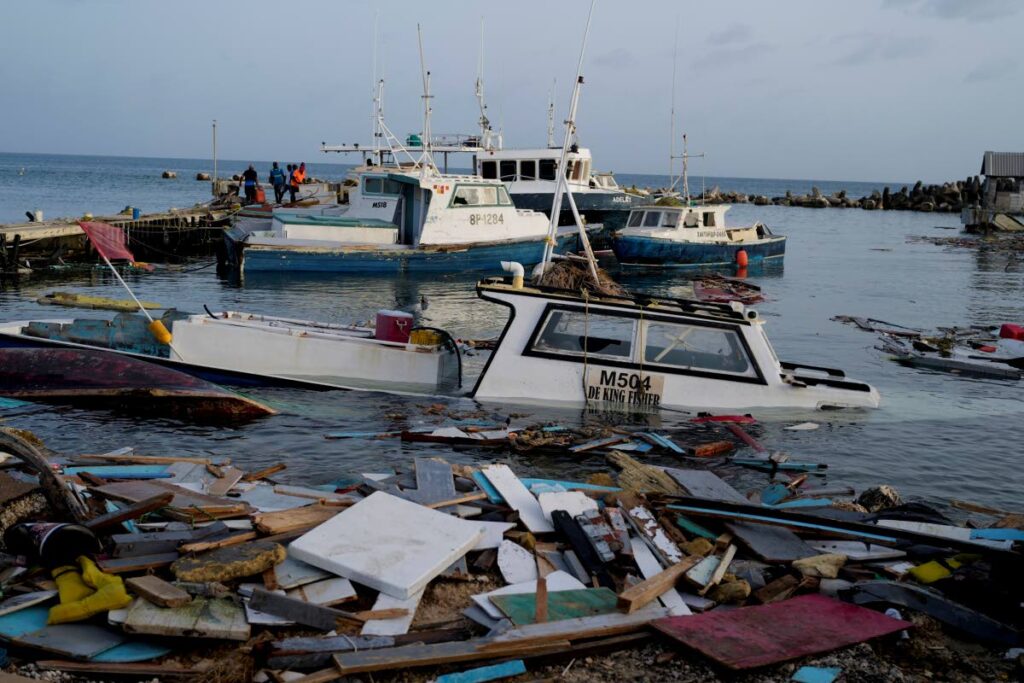Climate-change threat: a wake-up call for Trinidad and Tobago

Trinidad and Tobago’s Meteorological Service is, as local parlance says, taking in front before in front takes the country and is ramping up its communication about the effects of climate change.
Its director Shakeer Baig wrote an article about climate change and its effects which follows below.
Newsday asked his reason for doing so. Baig said, “TT has been observing what is happening globally with this entire phenomenon of climate change.
“Within the last few weeks, the World Meteorological Service would have published various publications about the increasing effects of climate change at the global level.”
Temperature and sea-level rise were examples of this and were pointing in a very dangerous direction.
Baig said he thought it was necessary to, from the TT perspective, tell the population about climate change and its devastating effects on small-island developing states (SIDS).
He said he did not want to wait until something happened and then say something.
The country did not have to go far to observe the phenomena’s effects. Increased temperature and reduced rainfall patterns showed this.
“This has put water management under stress,” he said. “It has also led to air-quality issues, people suffering heat strokes and people going to the public health institutions and straining a system that is already under stress.”
The more recent examples of hurricanes Milton and Beryl also demonstrated how urgent a matter climate change had become.

“Very early in the (hurricane) season we had a hurricane developing to category five, that is Hurricane Beryl and lasting for such a long period of time.
“Then we also have to look at the recent effects Hurricane Milton had on Florida.”
All of these things led the service to believe that the time had come to increase its communication around the issue and it planned to partner with the media to do so.
SHAKEER BAIG
As the climate crisis intensifies, small island developing states like TT are grappling with the escalating impacts of global warming.
The nation's pristine beaches, coral reefs and lush ecosystems are under threat, while rising sea levels, higher temperatures, diminished rainfall and extreme weather events present a looming existential crisis.
Vulnerability of SIDS
TT, along with other SIDS, faces unique challenges due to geographic location, limited resources, and reliance on climate-sensitive industries such as tourism and fishing. For these nations, climate change is not just an environmental concern –it is an urgent socio-economic and existential issue.
According to the UN Framework Convention on Climate Change (UNFCCC), SIDS are among the most vulnerable to climate impacts.
The Intergovernmental Panel on Climate Change (IPCC) predicts that sea levels could rise by up to a metre by the end of this century. This projection could lead to the submergence of low-lying areas, displacement of coastal communities and loss of critical infrastructure.
Rising sea levels: An immediate threat
TT’s coastal zones are already experiencing the effects of rising sea levels. Erosion has become a significant issue, with coastal communities losing valuable land, affecting livelihoods, homes, and public infrastructure. Areas such as Manzanilla and Mayaro have witnessed beach erosion, while flash flooding during the rainy season has become more frequent, putting pressure on already limited resources.
Additionally, the salinisation of freshwater resources, particularly groundwater, is exacerbating water-scarcity issues. This could have far-reaching consequences for agriculture and food security.
WMO report highlights growing shortfalls and stress in global water resources:
The year 2023 marked the driest year for global rivers in over three decades, according to a new report co-ordinated by the World Meteorological Organization (WMO), which signalled critical changes in water availability in an era of growing demand.
The last five consecutive years have recorded widespread below-normal conditions for river flows, with reservoir inflows following a similar pattern. This reduces the amount of water available for communities, agriculture and ecosystems, further stressing global water supplies, according to the WMO's State of Global Water Resources report (2024).
Other warnings:
Last year, 2023 was the driest year for global rivers in 33 years
Glaciers suffered largest mass loss in 50 years
Climate change makes the hydrological cycle becomes more erratic
Early warnings for all must tackle water-related hazards
Higher temperatures in TT
TT has been experiencing higher temperatures due to climate change, and these rising temperatures have several impacts across various sectors:

Human health
Heat-related illnesses: Higher temperatures increase the risk of heat exhaustion, heat stroke, and dehydration. Vulnerable groups, such as the elderly, children, and those with pre-existing health conditions are particularly at risk.
Vector-borne diseases: Warmer temperatures create favourable conditions for the breeding of mosquitoes, increasing the incidence of diseases like dengue, Chikungunya, and Zika.
Air quality: Heat can exacerbate air pollution, leading to respiratory issues, especially for people with asthma and other lung conditions.
Agriculture and food security
Crop stress: Extreme heat can reduce crop yields, affecting food production. Crops like cocoa, which are sensitive to temperature changes, may see lower productivity.
Water scarcity: Higher temperatures increase evaporation rates, reducing water availability for irrigation and livestock. This could lead to reduced agricultural productivity and higher food prices.
Pest proliferation: Warmer conditions may also lead to increased pest activity, which can negatively impact crops.
Water resources
Drought conditions: Rising temperatures contribute to prolonged dry spells and drought, reducing the availability of fresh water. This places stress on both households and industries dependent on water resources.
Increased evaporation: Higher evaporation rates reduce the levels of rivers, reservoirs, and other water bodies, leading to water shortages.
Energy demand
Increased cooling needs: As temperatures rise, there is an increased demand for air conditioning and refrigeration, which puts pressure on the energy grid and leads to higher electricity costs.
Strain on energy infrastructure: Higher temperatures can also affect the efficiency of power plants and increase the likelihood of power outages.
Coastal and marine ecosystems
Coral bleaching: Warmer ocean temperatures are causing coral bleaching, which threatens the rich biodiversity of coral reefs in the surrounding waters. This affects marine life and fisheries, which are vital for livelihoods and tourism.
Sea-level rise: Although primarily driven by global climate change, warmer temperatures contribute to the thermal expansion of seawater, increasing the risk of coastal erosion and flooding.
Economic impacts
Tourism: The tourism industry may suffer, as higher temperatures could deter visitors, and the degradation of coastal ecosystems could reduce the attractiveness of beaches and coral reefs.
Productivity loss: Outdoor workers, such as those in construction and agriculture, may experience reduced productivity due to heat stress. Higher temperatures can lead to fatigue and reduce work output.
Biodiversity and ecosystem services
Species migration: Rising temperatures can disrupt ecosystems by forcing plant and animal species to migrate or adapt to new conditions. This can lead to a loss of biodiversity and negatively impact ecosystem services, such as pollination.
Forest fires: Increased temperatures, combined with dry conditions, elevate the risk of forest fires, which can have devastating effects on biodiversity and air quality.
Infrastructure and urban heat islands
Heat stress on buildings: High temperatures can damage infrastructure, including roads, bridges, and buildings. Materials expand under heat, leading to cracks and other structural issues.
Urban heat islands: Cities like Port of Spain experience the "urban heat island" effect, in which densely built-up areas are significantly hotter than rural areas. This exacerbates the effects of heat on urban populations, particularly during heatwaves.
Intensified weather events
SIDS are also vulnerable to more frequent and severe extreme weather events. TT, located in the hurricane belt, has seen a marked increase in the intensity of storms.
The region’s infrastructure, designed for less severe conditions, is not always equipped to handle the extreme storms associated with climate change, leading to loss of property and increased recovery costs.
Economic impact
The economic toll on TT cannot be ignored. Tourism, a vital industry for many Caribbean nations, is at risk.
Coral reefs, which are vital for marine biodiversity and attract tourists from across the globe, are being bleached and degraded by rising ocean temperatures and ocean acidification.
The fishing industry is similarly affected, as fish stocks are becoming less reliable owing to changing ocean currents and warming waters.
Additionally, government spending is being redirected to disaster recovery and adaptation measures, straining already limited public finances.
With a growing frequency of disasters, the cost of rebuilding and recovery is expected to escalate, diverting resources from other critical areas like education, healthcare, and infrastructure development.
A call for urgent action
The impacts of climate change on TT underscore the urgency of global climate action.
While SIDS contribute the least to global greenhouse-gas emissions, they suffer the most from its effects. International support, including financial aid and technological transfer, is crucial for adaptation and mitigation efforts.
Locally, TT is ramping up efforts to address climate change. The government has made strides in renewable energy development and has pledged to reduce its carbon emissions.
However, more needs to be done to protect vulnerable communities, restore ecosystems, and transition towards a climate-resilient economy.
Conclusion
For TT, climate change is not a distant future threat – it is a present-day reality. The survival of SIDS depends on both local adaptation strategies and a concerted global effort to curb carbon emissions. Time is running out, and without immediate action, the very existence of these nations may be at stake.
The world must stand in solidarity with SIDS like TT, advocating for policies that protect the most vulnerable and ensuring a just and sustainable future for all.
Shakeer Baig is a doctoral candidate, director of the TT Meteorological Service, and TT's permanent representative to the World Meteorological Organization

Comments
"Climate-change threat: a wake-up call for Trinidad and Tobago"